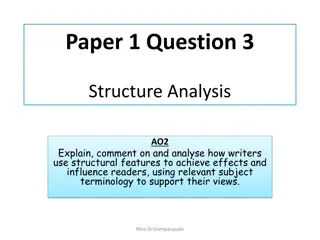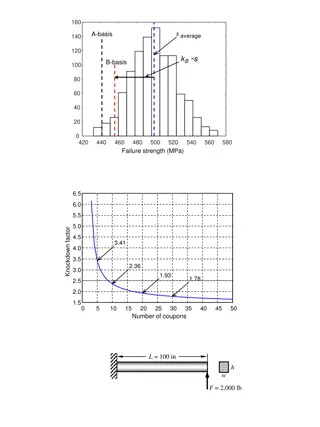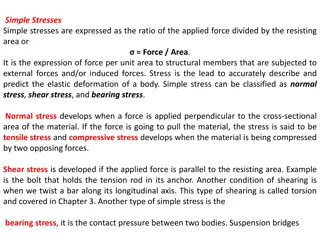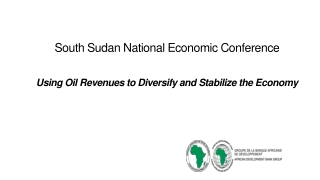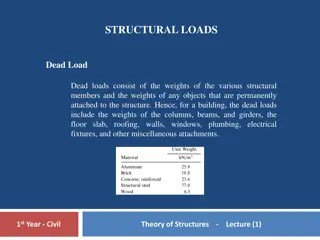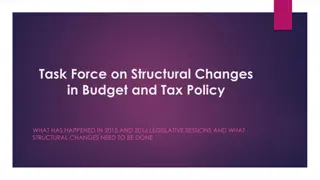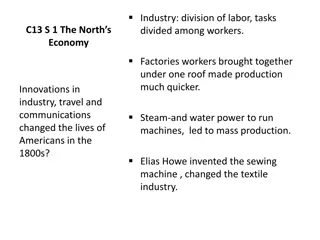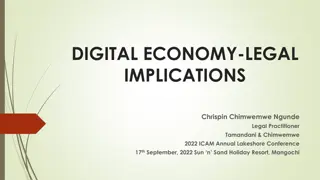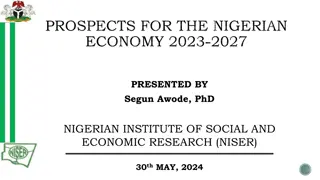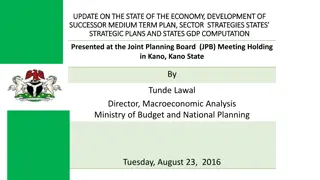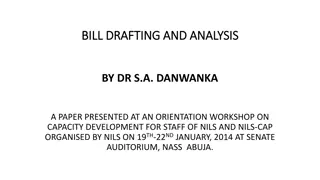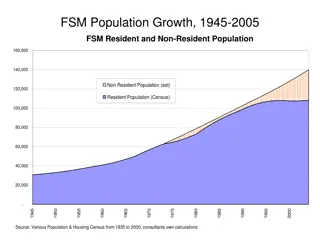Analysis of Structural Transformation Trends in the Nigerian Economy
Economic development entails growth accompanied by structural change and technological advancement. This analysis delves into the patterns and trends of structural transformation in the Nigerian economy as discussed by Prof. Olu Ajakaiye, Executive Chairman of the African Centre for Shared Development, focusing on diagnostic tools, insights, comparative analyses, and lessons learned from other countries. Achieving structural transformation requires deliberate planning and collaboration between public and private sector entities.
Download Presentation

Please find below an Image/Link to download the presentation.
The content on the website is provided AS IS for your information and personal use only. It may not be sold, licensed, or shared on other websites without obtaining consent from the author. Download presentation by click this link. If you encounter any issues during the download, it is possible that the publisher has removed the file from their server.
E N D
Presentation Transcript
STRUCTURAL TRANSFORMATION OF THE NIGERIAN ECONOMY: ANALYSIS OF PATTERNS AND TREND PROF. OLU AJAKAIYE EXECUTIVE CHAIRMAN AFRICAN CENTRE FOR SHARED DEVELOPMENT CAPAICTY BUILDING IBADAN A PRESENTATION AT THE 15THMEETING OF THE 2016 JPD&NCDP, AUGUST 23-25, 2016 AT TAHIR GUEST PALACE, NASARAWA GRA, KANO, KANO STATE
OUTLINE Introduction Diagnostic Tools for Structural Transformation Insights from Diagnosis of Structural Transformation of Nigerian Economy Pattern and Trend of Structural Transformation of Typical Economies Pattern and Trend of Structural Transformation of Nigerian and Comparator Economies Insights from Comparative Analysis of Patterns and Trends of Structural Transformation Lessons of Experience of Comparator Countries Planning for Achieving Structural Transformation of Nigerian Economy Contents of a Typical Participatory MTP International Partnership in Support of Structural Transformation of Nigerian Economy Other imperatives
Introduction Economic development is growth plus structural change and technological sophistication Economic growth is a necessary condition but not sufficient for structural transformation Economic growth unaccompanied by structural transformation is recipe for excessive concentration of the economy, non-inclusive growth, jobless growth and paradoxical growth and rising poverty. Structural transformation of an economy is the reallocation of economic activities away from low productivity to high productivity activities necessitated by the need to move the economy from the present state to a desired specified state. Structural transformation can also be presumed to have occurred if the contributions of the various economic activities to the total is not too large i.e., the economy is diversified. Structural transformation of an economy is best achieved in an environment of deliberate, judicious, dynamic, pragmatic and contextually relevant combinations and coordination of public and private sector institutions and instruments by Government in order to achieve a specified desired development goals. See Ajakaiye (2014 and 2015) further details Put simply, structural transformation is unlikely to occur in an unplanned economy
Diagnostic Tools for Structural Transformation Decomposition of Productivity into within sector changes in productivity, changes in productivity across sectors and joint effects of changes in productivity and employment shares between two time periods P = ?(??? ??0) S?0 + ?(??? ??0) P?0 + ?(??? ??0) * (??? S?0) Diversification index is simply the coefficient of variation in the contributions of different sector to total out (GDP) or other aggregates of interest, e.g. exports and imports C? = / (Coefficient of variation is standard deviation divided by the mean) The lower the Cv, the more diversified the economy
Insights from Diagnosis of Structural Transformation of Nigerian Economy Economic activities have been reallocated away from low productivity agric to low productivity services The Nigerian economy has been undiversified These are all contrary the aspirations of NV2020 where the objective was to reallocate economic activities from Agric to manufacturing and modern services Failure to achieve structural transformation is a consequence of abandoning planning during the most auspicious time in Nigerian economic history (2000-2014) It is imperative to quickly return to rigorous planning at Federal and State levels
Pattern and Trend of Structural Transformation of Typical Economies The literature suggests that a rapid increase in the share of industry and a decline of the agricultural share, i.e., industrialization initially plays a key role in catapulting the economy onto a higher growth path Typically most attention is paid to the size of the manufacturing sector as economic development is often thought to be closely associated with industrialization. Therefore as the economy grows, the contribution of agriculture should decline while that of manufacturing should rise and as the economy advances towards knowledge economy, the share of services should increase
Pattern and Trend of Structural Transformation of Typical Economies ctd In essence at early stages of development, agriculture or primary production tends to dominate As development progresses, manufacturing becomes dominant At the advanced stage, modern sophisticated services dominate We compare the growth and pattern of structural transformation in Nigeria with those of comparator countries - China, Indonesia, Malaysia and South Korea
Average Annual Growth Rates, 2000-2014 AVERAGE GROWTH RATE 3.2 South Africa Korea 4.4 5.1 Malaysia Indonesia 5.3 7.9 Nigeria 9.7 China 0 1 2 3 4 5 6 7 8 9 10 Clearly, Nigeria and the comparator countries met the growth imperative for Structural Transformation Indeed Nigeria out-performed all but China However, Figures (a-f) indicate that it is only in Nigeria that the decent growth of the period under consideration was not accompanied by significant structural transformation!!!.
Pattern and Trend of Structural Transformation - China
Pattern and Trend of Structural Transformation - Indonesia
Pattern and Trend of Structural Transformation - Malaysia
Pattern and Trend of Structural Transformation South Korea
Insights from Comparative Analysis of Patterns and Trends of Structural Transformation The pattern of structural transformation in Nigeria has been from primary production (oil and agric) to services sector dominated by informal rudimentary and low productivity distributive trade premature tertiarization of the economy The trend has been systematic consolidation of the premature tertiarization syndrome and the associated continuing disarticulation of the economy resulting in weakening inter-industry linkages, rising unemployment, poverty, inequality and stagflation These are contrary to the aspirations of NV20:2020 which specified that the contribution of manufacturing to GDP should be at least 25% by 2020 whereas as at 2015, it is only 9.5%. Also, the Global Competitiveness Index (GCI) of the World Economic Forum(WEF), 2014- 2015 still classifies Nigeria as a factor driven economy the lowest stage of development despite its impressive average annual growth of around 8 per cent between 2000 and 2014. (WEF, 2015: 282)). By contrast, China, Indonesia, Malaysia and South Africa are at efficiency driven stage of development while South Korea is already at the innovation driven stage of development (the highest stage of development).
Insights from Comparative Analysis of Patterns and Trends of Structural Transformation The upshot of the foregoing is that while Nigeria performed well in terms of growth profile between 2000 and 20014, the growth was factor (crude oil and primary agriculture ) driven and was not accompanied by significant structural change. When the factor that drove the growth started to falter from June 2014, the growth process was terminated and we are now in recession!!! Again, the abandonment of rigorous participatory medium term planning (the veritable bridge between NV20:2020 and the annual budgets) during the most auspicious time has resulted in a disarticulated economy characterized by the paradox of growth accompanied by intensifying misery featuring rising poverty, inequality, unemployment and inflation!!!
Lessons of Experience of Comparator Countries Development experiences of the comparator (Asian) countries where growth has been accompanied by structural transformation suggests that their success rests squarely on: Political commitment of the leadership to maximizing welfare of the people; Creation and maintenance of a competent and highly motivated largely meritocratic bureaucracy with appropriate autonomy and embeddedness Strategic and pragmatic state intervention aimed at investing in people, science and technology; investing in social, institutional and economic infrastructure and efficiently and effectively nurturing, supporting and promoting development of world class indigenous private sector operators, organizations and institutions able and ready to partner with their foreign counterparts to their mutual benefits and complementary to national development agenda articulated in a participatory development plan
Lessons of Experience of Comparator Countries ctd A cooperative, complementary and collaborative public-private interface and avoidance of adversarial relationship among public and private agents A realization that the pragmatic choice is not between the state and market but between different combinations of public and private institutions by the state in delivering sustainable growth and structural transformation. Avoidance of capture and rent seeking behavior as well as readiness to adjust policies quickly once credible and convincing evidence shows that certain strategies and policies are no longer applicable in light of emerging circumstances.
Planning for Achieving Structural Transformation of Nigerian Economy The initiative of re-creating Ministry of Budget and National Planning at the Federal level should be replicated at the State level States that are yet to create such a ministry should .do so The Federal Ministry of Budget and National Planning should organize a National Development Summit to be attended by the national leadership of all stakeholder groups, including those of Federal MDAs, Committees of National Assembly on Planning and Economic Development, State Government Planning Agencies, State Assembly Committee on Planning and Economic Development, the political parties, private sector organizations, labour union organizations, professional organizations and major civil society organizations.
Planning for Achieving Structural Transformation of Nigerian Economy The purpose of this Summit is to build consensus on the objectives of the medium-term plan and agree on key priority actions to be taken by each of the stakeholder groups working in concert to achieve the plan objectives. State Ministries of Budget and Planning should also organize a State Development Summit to be attended by the leadership of Federal Ministry of Budget and National Planning, State Government MDAs, State Assembly Committee on Planning and Economic Development, Chairmen of all Local Government Councils, the State Leadership of all stakeholder groups, including political parties, private sector organizations, labour organizations, professional organizations and major civil society organizations such as State Council of Women Societies.
Planning for Achieving Structural Transformation of Nigerian Economy ctd The objective of the Summit is to build consensus on the objectives and targets of the state medium term plan and agree on key priority actions to be taken by each stakeholder groups working in concert to achieve the plan objectives. Federal Ministry of Budget and National Planning and the State Planning Agencies should prepare their respective Federal and State Medium term Rolling Development Plan based on the outcome of the respective National and State Development Summits for consideration and approval by the Federal and State Executive Councils and subsequent transmission to the National and State Assemblies for adoption by resolution the way they do with MTEF/MTSS. Copies of the Plan should be made available to all participants at the National Development Summit and to the general public.
Contents of a Typical Participatory MTP The Federal and State Plans should contain: a precise statement of the development objectives based on the outcome of the National and State Development Summits Federal and State Government investment programmes required for the achievement of the medium term development goals agreed upon at the Development Summits; estimates of private sector investment profile necessary to secure the contributions of the private sector to the achievement of the agreed development objectives. broad directions of monetary, fiscal, trade, exchange rate, incomes, sectoral and other development policies that are compatible with the enabler roles and constitutional responsibilities of Federal and State Governments and also complementary to the achievement of the development objectives during the plan period; and
Contents of a Typical Participatory MTP Ctd A macroeconomic framework including the basic macroeconomic projections and sectoral development targets all of which are conditional on the public investment programmes, estimates of private sector investment profile and the complementary monetary, fiscal, trade and other structural and social development policy directions. Articulation of the human resources required for the plan and the employment implications of the plan Articulated/Institutionalized of collaborative monitoring, evaluation and impact assessment framework to be coordinated by the Ministries of Budget and Planning Articulated Institutionalized framework for effective periodic (half yearly) deliberations by relevant stakeholder groups at Federal, State an Local Government levels where the monitoring reports will be considered for validation and subsequent presentation to the Federal and State Executive Councils for approval and eventual transmission to the National and State Assemblies for adoption by resolution
International Partnership in Support of Structural Transformation of Nigerian Economy In this regard, development partners should: channel their development assistance to projects that will increase competitiveness of recipient nations; encourage their MNCs to actively seek out and support local industrialists to become part of regional production networks; supplement diversification efforts of the Nigerian Government by providing financial assistance through preferential export financing and similar options
Other imperatives NBS should be empowered and supported to produce regular, comprehensive, integrated data on all aspects of the economy and society necessary to guide and gauge national development including structural transformation of the economy. The initiative to produce State GDP should be sustained and finalized MNBP should originate an executive bill making participatory development planning mandatory and not optional MTEF and MTSS are insufficient MNBP should rebuild capacity of PRS at Federal level and JPB should mandate MBNP to incorporate State Govts in the capacity building process MBNP should pursue the possibility of pooling and professionalizing planning officer cadre at the Federal and state Levels without prejudice to their prospects of rising to the top of their careers in the civil service





